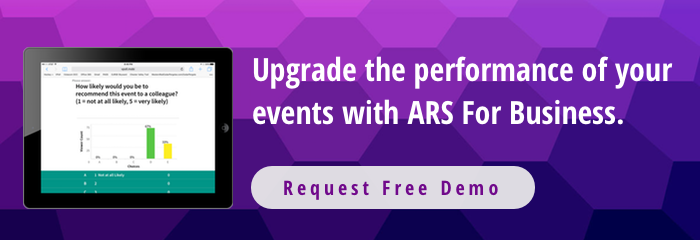Corporations and businesses of all sizes are investing more resources in continued education programs, event marketing, and conferences. As executive interest has grown, so have demands for performance reporting that extends beyond tactical indicators of organizational planning success.
To accommodate these demands, events organizers are leveraging audience response systems (ARS) that measure the true ROI and value derived by participants. Using a single platform, organizers are able to monitor, analyze and respond to the needs of participants in real-time, across multiple markets and over extended periods of time.
Deploying pre and post event surveys
Understanding the perceptions and objectives of event attendees is paramount when optimizing meetings for success. Aggregated pre- and post-event survey data can be used to better plan core messages, speakers and presentations included in future events.
In order to calculate ROI, baseline data must be collected before events. After establishing strategic benchmark questions, key strengths and opportunities of growth can be isolated with ease. Audience response systems can be setup to administer pre-event surveys as well as live and post-event surveys.
With the reporting from pre- and post-event surveying, meeting, training and event organizers can:
- Measure changes in the attitudes, perceptions, skills, and understanding of participants
- Measure the likelihood that attendees will act on new information
- Measure the long-term impact of meeting attendance on participants’ behaviors, commitments and results
Pre- and post-event surveying is especially useful for employee trainings, customer/user education, and continued education programs hosted by businesses, professional associations and other organizations.
Cross market data aggregation, simplified
Professional associations and event marketing divisions can be responsible for upwards of 100 similar events over the course of a year. HR departments, too, can deliver tens to hundreds of similar employee trainings across multiple different markets. Using audience response, variations in impact by market can be measured and compared.
Here’s a sampling of qualitative and quantitative data that’s often measured:
- Live polling participation rates
- Knowledge retention quiz scores
- Audience Q&A participation rates
- Voting preferences and participation rates
- Overall event satisfaction scores
- Open ended survey responses
- Session feedback scores
Comparing aggregated data year over year
Event organizers with barely enough time to breathe need not worry about recreating audience surveys after each event. With audience response systems, surveys can be administered to support multiple events. Not only is this method significantly less time consuming, but it’s also more economical and accurate than paper surveys.
Further business value can be derived from ARS audience feedback and engagement data by mapping year-over-year trends to overarching business goals. With a bit of tech savvy, event organizers can apply ARS data trends to data collected in other departments using CRM, marketing and financial management tools.
Track more than “getting your name out there”
With audience response systems, the process for collecting and responding to event data is both simplified and optimized for accuracy. Life is easier for the event planners, HR professionals, and department leaders in charge of strategic events. With a robust reporting and feedback monitoring, organizers can make event design and experience delivery.

